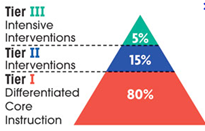RTI
A Parent’s Guide to Response to Intervention (RtI)

What is RtI?
Changes in federal and state laws have directed schools to focus more on helping all children earlier within the general education setting. Response to Intervention (RtI) is a research/evidence-based instructional and intervention model that identifies students who are having difficulty achieving in the core curriculum.
What are the benefits to RtI?
Perhaps the greatest benefit of an RtI approach is that it eliminates a “wait to fail” situation because students get help promptly. As soon as assessment data indicates a problem area for students an intervention is put into place to address these concerns.
What is the RtI process?

Tier I:
- Core curriculum & instruction
- All Students
Tier II:
- Small group interventions outside core curriculum instruction.
- Provided in addition to Tier I.
Tier III:
- Intense interventions often provided in a one-on-one setting.
- Students not responding adequately to the interventions may be referred for a special education screening.
Parents are an important part of RtI!
How can parents be involved?
- Communicate frequently with your child’s teacher.
- Attend school activities such as parent-teacher conferences.
- Help your child with homework assignment.
- Praise your child for any progress or improvement.
- Read with your child each night.
- Review sight words, math flash cards, and spelling words at home.
- Share with your child’s teacher what works well at home.
- Always ask questions when things are not clear.






